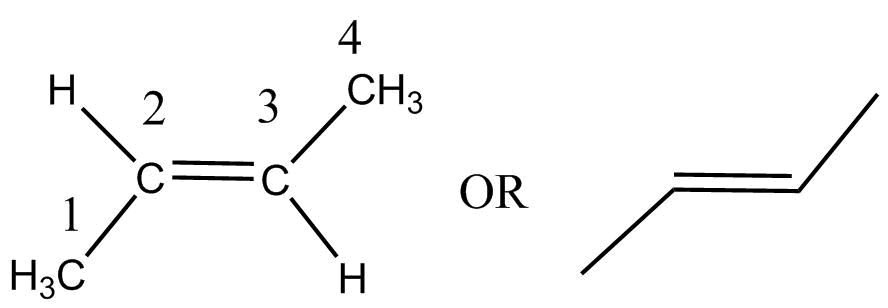
Name the compound
$C{H_3} - CH = CH - C{H_3}$
Answer
572.1k+ views
Hint: This is the example of unsaturated hydrocarbons. Unsaturated hydrocarbons are hydrocarbons that have double or triple covalent bonds between adjacent carbon atoms. The term unsaturated means more hydrogen atoms may be added to the hydrocarbons to make it saturated.
Complete step by step answer:
$C{H_3} - CH = CH - C{H_3}$
This is a But-2-ene compound. It is named so because it has a double bond on the second carbon atom .
(1) The chemical formula for butane is: ${C_4}{H_8}$ which means it is made up of four carbon atoms and eight hydrogen atoms. The $ene$ part of the name refers to an alkene. So we know that butane’s structure must include a carbon double bond.
(2) There are several different isomers or molecular structures, that this compound can form:




Additional information:
The relationships between each of these isomers are mostly constitutional, which means they have the same molecular formula but have different bond connections (Order).
Meaning to transform them, you would have to just move around the hydrogen and carbons in other words the atoms and functional groups.
Note:
These isomers of butane are made up from the same materials, they each have different properties.
With cis-beta-butylene and trans-beta-butylene the atoms are in the same order, but the polarities are not same . The $cis$ isomer is polar, with both $C{H_3}$ groups on the same side. This makes it really bulky and difficult to stack.
Complete step by step answer:
$C{H_3} - CH = CH - C{H_3}$
This is a But-2-ene compound. It is named so because it has a double bond on the second carbon atom .
(1) The chemical formula for butane is: ${C_4}{H_8}$ which means it is made up of four carbon atoms and eight hydrogen atoms. The $ene$ part of the name refers to an alkene. So we know that butane’s structure must include a carbon double bond.
(2) There are several different isomers or molecular structures, that this compound can form:
Alpha-butylene $\left( {but - 1 - ene} \right)$

$C$ is beta-butylene- $\left( {\left( {2z} \right) - but - 2 - ene} \right)$

Trans-beta-butylene- $\left( {\left( {2E} \right) - but - 2ene} \right)$

Iso butylene $\left( {2 - methylprop - 1 - ene} \right)$

Additional information:
The relationships between each of these isomers are mostly constitutional, which means they have the same molecular formula but have different bond connections (Order).
Meaning to transform them, you would have to just move around the hydrogen and carbons in other words the atoms and functional groups.
Note:
These isomers of butane are made up from the same materials, they each have different properties.
With cis-beta-butylene and trans-beta-butylene the atoms are in the same order, but the polarities are not same . The $cis$ isomer is polar, with both $C{H_3}$ groups on the same side. This makes it really bulky and difficult to stack.
Recently Updated Pages
A man running at a speed 5 ms is viewed in the side class 12 physics CBSE

State and explain Hardy Weinbergs Principle class 12 biology CBSE

Which of the following statements is wrong a Amnion class 12 biology CBSE

Two Planoconcave lenses 1 and 2 of glass of refractive class 12 physics CBSE

The compound 2 methyl 2 butene on reaction with NaIO4 class 12 chemistry CBSE

Bacterial cell wall is made up of A Cellulose B Hemicellulose class 12 biology CBSE

Trending doubts
What are the major means of transport Explain each class 12 social science CBSE

Which are the Top 10 Largest Countries of the World?

Draw a labelled sketch of the human eye class 12 physics CBSE

Explain sex determination in humans with line diag class 12 biology CBSE

The pH of the pancreatic juice is A 64 B 86 C 120 D class 12 biology CBSE

Give 10 examples of unisexual and bisexual flowers




